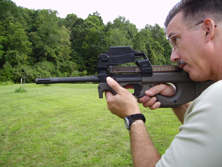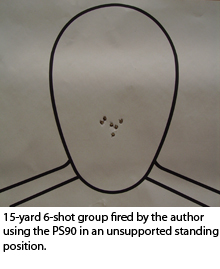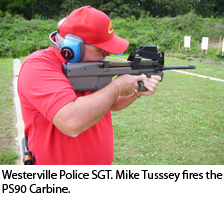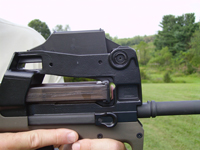Let's look at a new weapons system from Fabrique Nationale: The PS90 carbine.
 American shooters and law enforcement officers have a history of being a very conventional, traditional, and at times, stodgy lot. History is replete with examples.
American shooters and law enforcement officers have a history of being a very conventional, traditional, and at times, stodgy lot. History is replete with examples.
How History Bucks Innovation
Famous gunfighter and lawman Wild Bill Hickock continued to use a brace of .36 caliber Colt Navy cap-and-ball revolvers as his primary armament until his untimely death in 1883, long after cartridge revolvers were in widespread use.
Colt introduced the double-action revolver, in a form that has remained nearly unchanged, in 1892. Yet lawmen in Western states still continued the use of single-action Colt revolvers until WWII, and probably, even today, you can find a local lawman somewhere in a remote corner of the west (or Alaska) still packing a single-action revolver as primary armament.
And speaking of double-action revolvers, the NYPD, the largest police agency in the world, didn’t drop its double-action .38 revolvers as the primary duty weapon until the 1990s. The 1911 single-action pistol has been around since well, 1911.
Yet it is only in the last 15 years or so, and particularly in the last five that we have seen a veritable explosion in its popularity and the number of manufacturers making and modifying and providing accessories for this previously “specialist only” pistol-putting this pistol in the hand of seemingly every serious/semi-serious pistol shooter. But it took almost 100 years to get to this point!
Another example is stainless steel and synthetic stocks. These have been available since the 1960s for hunting rifles, but they had been ignored in favor of traditional walnut and blued steel for 30 years or so until the majority of shooters figured out the advantages of these materials in bad weather situations.
Lets give some credit where credit is due. We aren’t always THIS stodgy. For example the Glock pistol took off like a rocket after initial (and fraudulent) media reports provoked concerns about its polymer construction slowed its acceptance.
After the truth came out, the rise to prominence was nearly meteoric and Glock now holds the majority share of the law enforcement market– a remarkable and unparalleled achievement.
In doing my review of the FiveseveN pistol and the PS90 carbine, I wanted to keep this history in mind. As this duo is still relatively new to the civilian shooter (or privately purchased LE market) I felt that the guns should be viewed in terms of three factors, or portions of these factors, in order to determine shooter acceptability.
These factors all directly affect the end user, the shooter. Are these guns, or parts of them innovative, unconventional or odd? Why? If the guns are innovative, they will be accepted in rather short order. Glock’s design is innovative.
The polymer frames, high reliability and user-friendly simplicity made them a market success. If guns are unconventional, there will be some acceptance issues. While an entire weapon may be innovative overall, parts of it may be unconventional. Glock’s Safe-Action™ trigger system, was at the time of introduction, unconventional — there was no other manual safety on the weapon that had to be engaged or disengaged for use. There wasn’t even a de-cocker.
While today this system is mostly viewed as innovative (and actually normal), there are still a number of police administrators that view Glocks as unsafe and unconventional and will not permit their issue or use.
Finally, if a gun or parts of it are viewed as odd, then we have a serious acceptance problem. There are two examples that come to mind, both developed in the 1960s, of odd guns that never made it. The first was the Gyrojet pistol. This odd weapon fired rocket-powered cartridges in both pistol and rifle form. It was neither accurate nor particularly powerful.
Its rocket projectiles could be stopped by the human hand at the end of the barrel without damage since they hadn’t gained sufficient velocity. It took several feet of travel to gain appropriate speed. The second was the Dardick pistol, a very strange pistol that was a combination of revolver and semi-automatic pistol that fired a .38 caliber plastic cased “tround” cartridge that contained bullet and powder. Both guns looked toy-like and are now collector’s items.
So with these parameters in mind let’s look at a pair of new weapons systems, and the cartridge they fire. From Fabrique Nationale come the FiveseveN pistol and the PS90 carbine. First lets examine the PS90 carbine.
Fabrique Nationale PS90 Carbine
 The PS90 is the civilian-legal version of the original P90, which was designed as a “personal defense weapon” for specialized military personnel whose main duties do not revolve around the military rifle. These troops are normally issued a pistol as a personal defense weapon. For U.S. forces that pistol is the Beretta M-9. These soldiers include tank or artillery crews, pilots and air crewmen, and troops operating to the rear of forward areas.
The PS90 is the civilian-legal version of the original P90, which was designed as a “personal defense weapon” for specialized military personnel whose main duties do not revolve around the military rifle. These troops are normally issued a pistol as a personal defense weapon. For U.S. forces that pistol is the Beretta M-9. These soldiers include tank or artillery crews, pilots and air crewmen, and troops operating to the rear of forward areas.
However, it has long been felt that the pistol, in the hands of the average soldier is not up to the task. I have to agree to a large extent. If our military pistol shooters had trained up to a reasonable level in IPSC or IDPA-style shooting for example, I might feel differently. But such is not the case and military training with the pistol for non-spec ops personnel is very basic.
Further, not everyone has the same abilities. What those in the research areas felt was needed to compensate for lack of proficiency with a pistol was a handy, shoulder-fired weapon of high magazine capacity and adequate power. The goal was to have a firearm that could be carried conveniently for extended periods of time in place of the pistol, and that would allow hits out to 100 yards or so.
The PS90 Carbine As a Defensive Weapon
 This new weapon design was not to be an assault (taking the initiative) weapon, but rather a defensive (holding the position or covering the retreat) weapon.
This new weapon design was not to be an assault (taking the initiative) weapon, but rather a defensive (holding the position or covering the retreat) weapon.
Does the M-1 Carbine of WWII fame come to mind here? Same problem, different time. In fact, wasn’t switching to an easier-shooting 9mm from the .45 supposed to solve most of these “problems”? Guess it didn’t.
However, one new wrinkle to the M-1 Carbine twist was that the weapon needed to penetrate the body armor worn by Soviet (Russian) or Chi-com/North Korean forces.
Like the original M-1, the new PD weapon needed to be light-recoiling and easy to fire. Unlike the M-1, it was to be full-auto capable with a large magazine capacity and as a part of FN’s design plan, totally ambidextrous in operation.
What FN ended up with was, well, a very cool weapon, futuristic in appearance and totally unique, the P90. While the P90 is already in use by a number of agencies such as the Secret Service, and is also the signature weapon of the science fiction television show Stargate, it has not been adopted, at least by the U.S., in its intended military role.
The civilian-legal counterpart, the PS90, retains most of the characteristics of the original P90 plus all of the overwhelming “cool factor”.
Lightweight, Compact Close-Quarter
According to the manual the PS90 is a blowback-operated bullpup carbine firing from a closed breach. It weighs 6.61 lbs. (which is really deceiving, since it seems much lighter, undoubtedly due to its small size), has a maximum width of 2.3 inches and an overall length of only 26.3 inches and has a fixed optical sight.
 It is truly ambidextrous in operation, with the disk-shaped safety capable of being operated by the trigger finger of either hand, pulling it toward you to fire if you are right-handed, and pushing it away from you if you are left handed.
It is truly ambidextrous in operation, with the disk-shaped safety capable of being operated by the trigger finger of either hand, pulling it toward you to fire if you are right-handed, and pushing it away from you if you are left handed.
Cartridges are fed through a translucent amber-colored polymer magazine that sits flush on top of the stock, but underneath the sighting module, parallel with the bore and chamber. Release the magazine by operating either of the two magazine releases on either side of the magazine at the chamber.
Ejection is downward through the large ejection port, located aft of pistol grip portion of the weapon. No empty casings will hit your face, no matter which way you hold the weapon on while firing.
The weapon is charged by grasping one of the ambidextrous cocking handles located on either side of the barrel assembly, and pulling directly backwards. The trigger, which has been complained about by some, is to me, ok.
I originally agreed with the opinions of the trigger, but I went back to the original concept that this is an emergency defensive weapon, and that the trigger is the essentially set up the same as the full-auto version, to allow for controlled fire bursts, not long-range sniping.
What's Different from the P90?
With that being said, there are only three things that differentiate it from the P90. The first is the civilian legal 16-inch barrel (which still puts the OAL about the same as the excellent M-16 Clinic Viper™ with its 7.25 inch barrel) and gives improved ballistic performance to the 5.7 x 28 cartridge over the much shorter P90 barrel.
The second is that the PS90 fires in semi-automatic mode only.
The third is that it is shipped with a single 30-round magazine that is marked as a 50-rounder. The magazine spring is modified to allow for loading of only 30 rounds. Fifty-round magazines are available from internet suppliers.
The overall assembly is modular in format, and breaks down easily for cleaning. There is a single sling attachment slot in the toe of the buttstock. Up to this point, everything I have described falls under the classification of being innovative.
First Impressions: Cool, But…
Now lets look at the PS90 in subjective detail. When I first got my sample of the PS90, I kind of shook my head.
 Ok, it appeared, like I said, cool, but there were a number of things that bothered me about it. First was the price. Innovation comes with a price. The retail price is $1,500.
Ok, it appeared, like I said, cool, but there were a number of things that bothered me about it. First was the price. Innovation comes with a price. The retail price is $1,500.
I imagine that the price will come down somewhat as more of PS90’s become available, but heck, I could have a really sweet AR for that kind of money, and the PS90 didn’t even come with a sling (really, for $1,500 can we get a sling shipped with it, please?).
Also, I was troubled at first by the fixed Optical Ring Sights™ sighting system. They are not adjustable; at least there is no adjustment method described in the manual or visible on the sight. There are only two mounting screws. Chalk that up as odd.
I liked the small ring within the large ring for the reticle concept, but the field of view is very small, and under poor lighting the ghostly white (apparently a black ring is also available) reticle disappears until a parallel and perpendicular set of tritium bars that intersect the center circle appear to enhance the sight picture.
When I got home and tried the sights in a darkened room, I could see the tritium appear, but it is not what you would expect from tritium sighting. It is vaguely orange and not bright. That seemed unconventional, and borderline odd. It was not what I was used to.
But, I thought again, the PS90 is derived directly from an emergency combat weapon and is supposed to be durable and require no maintenance, and should be as idiot-proof as possible.
Innovative Sighting Solution
I guess the sights work, so they moved up to the unconventional level as I figured that what I would really like on the PS90 was a good red dot sight of some sort. But after working with it some more during live fire, and making another discovery about the sighting system, I moved the Ring Sight™ all the way up to innovative.
What was the discovery? Not mentioned in the manual is that the PS90 as well as the P90 have a set of AMBIDEXTROUS backup open iron sights built right into the barrel support and optical sight group assembly.
I only discovered this after dropping (sorry FN) the PS90 onto the carpeted floor (unloaded) and checking the optical sight. Suddenly there they were, one set on either side of the optical sight.
They were part of the construction, regulated on either side to the point of aim of the optical sight, in the same black coating that the rest of the assembly is covered in. If the Ring Sight™ is damaged in a mishap, you have the open sights to use in their place!
I have never seen anything like this before. They work just as well for the right- or left-handed shooter! This really ought to get a mention in the manual. Chalk up another one for being innovative.
Another issue for me that I was aware of from reading other reviews was that the PS90 had no last shot bolt hold-open feature. My disgruntlement was quickly dismissed during loading and firing.
Once the weapon has been shot empty, and you get the empty trigger “click,” you cannot easily see the chamber anyway with the magazine in place.
You have to check through the bottom ejection port to see the chamber with the magazine in place. In order to check and clear if you don’t want to remove the visibly empty magazine, you turn the weapon over and pull back on the charging handle and check. In the big scheme of things how big a problem is this really? Not having the hold-open also eliminates the need for an additional ambidextrous control built into the weapon, which reduces consumer cost.
As you can see, one must not be too quick to judge an entirely new design right away. It really takes time to develop an opinion, good or bad, when faced with evaluating a product with this much innovation, and this many unconventional features.
PS90: Ultra-Reliable, No Recoil
As I continued to work with the PS90, my opinion began to change even more. After several sessions at the Union County Sheriff’s Office range in Marysville, Ohio during both department M-16 qualifications and Columbus State Community College Police Academy firearms training, I not only changed my opinion on the points of contention outlined above (except the lack of a sling, and for that matter a spare magazine) I have grown to really love this little weapon.
Firing really drove home three positive (and innovative) aspects, even though I already knew of two. The first was that the system is totally, and I mean totally, reliable. The second is that there is no recoil, and very little muzzle blast, which was mitigated to some degree by the integral flash hider. The third, be careful when firing the PS90 either from a kneeling or sitting position. You start to accumulate a pile of warm empty casings on your leg since the ejection is straight down, right over the thigh.
Also be forewarned that if you are equipped with body armor by “second helping” rather than by Second Chance™, you will find your shirt streaked with small black casing sized marks from the downward ejection against your protuberance.
The gun and cartridge make for easy “minute of felon” hits at 100 yards, and some very nice groups at 25 yards and in, the range really intended for this gun. I know you are asking about cartridge performance, and I will get to that in future articles, but suffice it to say for now that this thing is loads of fun to shoot, and anyone that handled it had a big smile on before, during and after firing.
That was followed by the exclamation, “I have got to have one of these!” And those words from shooters who due to their, shall we say, lifetime of experience, have become a bit jaded.
For more information, www.fnhusa.com

Next Step: Get your FREE Printable Target Pack
Enhance your shooting precision with our 62 MOA Targets, perfect for rifles and handguns. Crafted in collaboration with Storm Tactical for accuracy and versatility.
Subscribe to the Gun Digest email newsletter and get your downloadable target pack sent straight to your inbox. Stay updated with the latest firearms info in the industry.

![Best Concealed Carry Guns In 2025 [Field Tested] Wilson Combat EDC X9S 1](https://gundigest.com/wp-content/uploads/Wilson-Combat-EDC-X9S-1-324x160.jpg)


![Best 9mm Carbine: Affordable PCCs [Tested] Ruger Carbine Shooting](https://gundigest.com/wp-content/uploads/Ruger-Carbine-Shooting-100x70.jpg)
![Best AR-15: Top Options Available Today [Field Tested] Harrington and Richardson PSA XM177E2 feature](https://gundigest.com/wp-content/uploads/Harrington-and-Richardson-PSA-XM177E2-feature-100x70.jpg)

I’d like to add that there is a dedicated forum for the PS90 on THE BULLPUP FORUM. Lots of info there for aftermarket support including short barrel (SBR) sources.
ALSO… I highly recommend buying ONLY the genuine FN magazine as the Korean made mags have had feed problems.
Finally, the Gen.3 PS90 models can easily accept an aftermarket LOW Picatinny rail to keep your red dot sight low so they instantly come up to your sight level with a normal cheek weld.
But because it must be placed forward to keep it low do NOT buy a “reflex” sight that needs a 2″ to 3″ eye relief spacing. Buy only “red dot” type sights. I like my fully enclosed Vortex SPARC II for its all weather ruggedness. It’s been banged around in training a bit and never got off zero.
I have had my PS90 for about 5 years and put about 300 rounds through it with no problems at all. I’ve added a Vortex SPARC II red dot sight on an aftermarket low Pic rail and now the sight comes up perfectly with my cheek weld. An extended left side charging handle, 2 sling rings for my MAGPUL Modular sling, two receiver short Pic rails and a Promoted Pawn trigger mechanism upgrade.
Because I never liked the FN Five seveN pistol and considered it WAY over priced I was very happy to see the new RUGER 57 pistol come out last year. I bought one last month and added a Kydex OWB holster, extra magazine (for total of 3) and two double mag pouches from The Vest Guy, same place that custom made my two double PS90 mag pouches. (If I ever have to move to the People’s Republic of California I’ll have to get rid of the PS90 and buy 10 round mags for the “57”.)
ZOMBIES BEWARE! I can now carry 312 rounds of that hard hitting 5.7 x 28 ammo, cocked and locked.
I like same-caliber carbine/pistol combos and have them also in .22 magnum and .44 magnum.